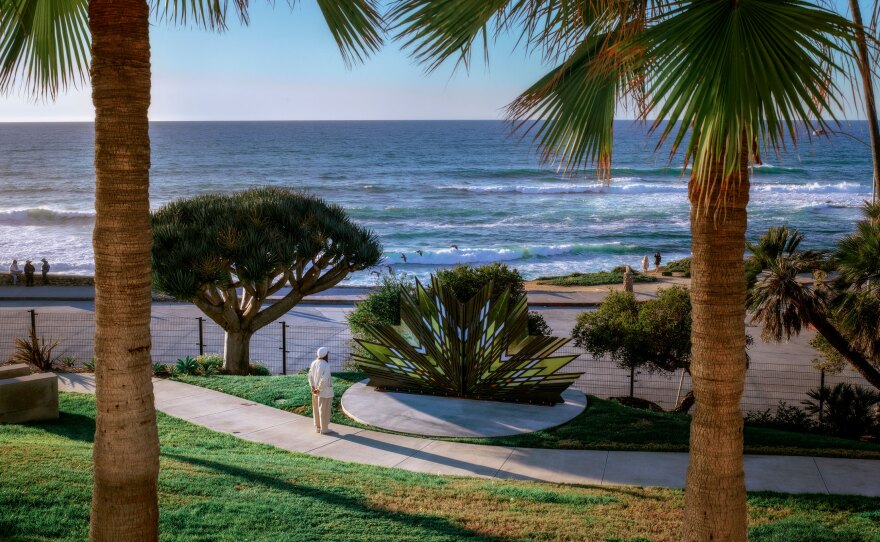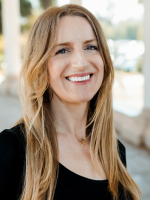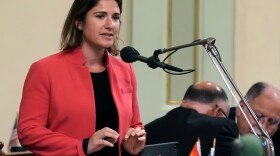Robert Irwin wanted to change the way people look at art. His emphasis on light and space had a way of making the objects at an exhibit secondary. And for some people, a bit of a question.
"Is it the shape? Is it the frame? The edge of the canvas? So he sort of systematically dematerializes or dismantles the art as we have thought of it before," said Kathryn Kanjo, director and CEO of the Museum of Contemporary Art San Diego (MCASD).
MCASD holds the largest collections of Irwin's work.
Irwin, who was born in 1928, started out as an abstract expressionist painter in the 1950s. But he soon evolved.
In the 1960s, a group of Southern California artists developed the Light and Space movement. These artists worked with light — whether with actual light bulbs, ambient light, shadows or the perception of light. Irwin is widely considered one of the movement's pioneers.

Kanjo said he began to evolve as an artist into questioning what constituted a work of art.
"We see him moving off the canvas and blurring, literally blurring the boundaries or the edges of what a painting is," Kanjo said. "That might sound a little abstract, but that's his work. It's about perception. It's about getting you to tune in to your place. And the environment around you."
"That's his work. It's about perception. It's about getting you to tune in. to your place. And the environment around you."Kathryn Kanjo, MCASD

His most famous work in San Diego is “1° 2° 3° 4°,” which features 3 square holes cut directly through MCASD's windows. The holes allow the breeze in, frame nearby palm trees and the coastline, and they blur the lines between inside and outside.
In an interview with KPBS in 2007, Irwin said he wanted to lean into the idea that what people may see out the window is as good as any art.
"Well, actually when I stopped being a studio artist, I was very interested in the idea of dealing with spaces, but I didn't want to objectify them. I didn't want things in them. I wanted you to deal with the quality of the space itself," Irwin said in 2007 of his approach to art and site.
"I was very interested in the idea of dealing with spaces, but I didn't want to objectify them. I didn't want things in them. I wanted you to deal with the quality of the space itself."Robert Irwin, 2007
Other Irwin works at MCASD refract light and blend into the wall. A recent installation of "Spanish Fan," an outdoor sculpture, was overseen by Irwin himself. The work was a gift from the artist.

More of Irwin's work is on view at the nearby Quint Gallery in La Jolla. Many of Irwin's pieces use actual fluorescent light tubes that transform and captivate when lit up. Others remain intentionally unlit.

Gallery owner Mark Quint said he was first introduced to Irwin's work when he was a young art student. When he finally had the chance to invite Irwin to exhibit in his gallery, Quint said he was intimidated to ask.
"I remember him saying to me when I finally did get the courage to ask for an exhibition, he said, 'What took you so long, kid?'" Quint said. "It was typical of Bob. He was just friendly. But at the same time, he had a type of energy and art world knowledge that made him kind of a hero personality, at least to me."
"When I finally did get the courage to ask for an exhibition, he said, 'What took you so long, kid?'"Mark Quint, Quint Gallery
Quint said Irwin's approach to space, light, art and perception was profound. And his legacy is one of encouraging people to really see. Not just art, but everything.
"I think of Bob, as a lot of people probably do, as a philosopher's artist. There are artists' artists. Bob was more concerned with the idea of looking, and seeing, and beauty and his legacy would be one of saying take a look. Look closely," Quint said.
Quint said that Irwin continued to work in his studio, even well into his 90s.
"He is an artist for the generations, but he comes out of our moment."Kathryn Kanjo, MCASD
When asked what Irwin's work meant to her, MCASD's Katherine Kanjo said it's his relevance here, in San Diego.
"Part of the beauty of contemporary art is that you can be — you want to be — in the place where history is being made. That if you tune in to the world around you that you can be in the throes of something very important. And being with and knowing Bob Irwin has meant that for me and for so many people in this community and in this museum in particular," Kanjo said.
"He is an artist for the generations, but he comes out of our moment."





